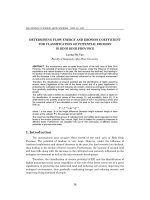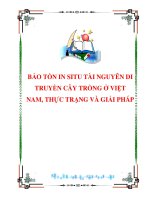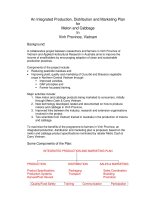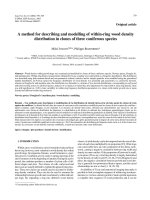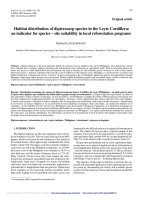Determine r coefficient for REDD benefit distribution in phu gia commune huong khe district hatinh province viet nam
Bạn đang xem bản rút gọn của tài liệu. Xem và tải ngay bản đầy đủ của tài liệu tại đây (439.11 KB, 53 trang )
MINISTRY OF AGRICULTURE AND RURAL DEVELOPMENT
VIETNAM NATIONAL UNIVERSITY OF FORESTRY
STUDENT THESIS
Title
Determine R-coefficient for REDD+ benefit distribution in Phu Gia
commune, Huong Khe district, Ha Tinh province, Vietnam
Major: Natural Resources Management
Code: D850101
Faculty: Forest Resources and Environmental Management
Student: Nguyen Huyen Thuong
Student ID: 1253090033
Class: K57 Natural Resources Management
Course: 2012 - 2016
Advanced Education Program
Developed in collaboration with Colorado State University, USA
Supervisor: Assoc. Prof. Dr. Phung Van Khoa
Hanoi, Oct/2016
TABLE OF CONTENT
ACKNOWLEDGEMENTS ............................................................................................ 1
ABTRACT.......................................................................................................................2
I. INTRODUCTION ........................................................................................................3
II. BACKGROUND ........................................................................................................8
III. GOALS AND OBJECTIVES..................................................................................16
3.1. Goals .......................................................................................................................16
3.2. Objectives ...............................................................................................................16
IV. METHODS ..............................................................................................................17
4.1. Study area ...............................................................................................................17
4.2. Determine the R-coefficient rule ............................................................................18
4.3. Secondary document collection method .................................................................19
4.4. Field data collection method ..................................................................................20
4.4.1. Direct interview ...................................................................................................21
4.4.2. Indirect interview.................................................................................................21
4.5. Data analysis ...........................................................................................................22
V. RESULTS .................................................................................................................23
5.1. Survey and interview results of individuals, households and departments in the
application of the R-coefficient in the benefit distribution system of REDD+ .............23
5.2. The calculating results of the R-coefficient ........................................................... 33
5.2. Propose some solutions to improve efficiency in payment mechanism for REDD+
project ............................................................................................................................ 37
5.2.1. For people perception .......................................................................................... 37
5.2.2. For management ..................................................................................................37
5.2.3. For participation of community ...........................................................................38
VI. DISCUSSION .........................................................................................................39
VII. CONCLUSION ......................................................................................................43
REFERENCES ..............................................................................................................45
APPENDIX ...................................................................................................................47
LIST OF TABLES
Table 3.1: Summary of the natural characteristics, socio-economic of Phu Gia
commune ......................................................................................................................18
Table 3.5: Factors being considered for the R-coefficient of REDD+, Vietnam ...........9
Table 3.6: Weight of each component factor of the R-coefficient Ri .......................... 15
Table 4.1: Survey and investigate results of indicators based on component factors of
the R-coefficient ...........................................................................................................23
Table 4.2: Calculating the R-coefficient for REDD+ ...................................................34
Table 4.3: Descriptive statistic for results of R-coefficient ..........................................36
Table 5.1: The total payment for each household per year ..........................................39
Table 5.2: Responsibilities and coordination in the process of calculating the Rcoefficient .....................................................................................................................41
ACKNOWLEDGEMENTS
To complete this scientific research, apart from my own efforts, I also receive a lot of
guidance and help from my teachers, organizations and individuals.
I would like to give our gratitude to my advisor Assoc. Prof. Dr. Phung Van Khoa for
giving me a constant support and enthusiasm guidance during the time of research and writing
of this thesis.
I want to sincerely thank leaders, staffs and citizens of Phu Gia commune, Huong Khe
district, Ha Tinh province - where my study deploy, who created favorable conditions for
during my data gathering and investigation process.
Once again, I would like to give our gratitude and look forward to receiving guidances
and comments from fellow scientists and colleagues.
In conclusion, I guarantee that the results and data presented in the research is honest
and objectively.
I sincerely thank you!
1
ABTRACT
The success of REDD + depends on the distribution an efficient and equity the
payments based on results. UN-REDD Programme supported for Vietnam Government
determined that the key issues need to solve when the build a benefit distribution system
(BDS) that suit with REDD+ requirement. Especially, the UN-REDD Programme in Vietnam
is assisting the design of the BDS framework for REDD+ in a number of way, including the
design and testing of a payment coefficient for benefits, “the R-coefficient”, as a mechanism
to help REDD+ deliver multiple benefits in Vietnam. The R-coefficient can also be regarded
as a kind of the ensure safety policy on the environment and society is being implemented
through the mechanisms of BDS. Therefore, the determined of payment mechanisms for
REDD + through R-coefficient effectively will reflect differences in the cost of emission
reduction between the groups or different locations. In this study, the survey and investigation
are conducted at Phu Gia Commune, Huong Khe District, Ha Tinh Province. The payment
mechanics of the R-coefficient are calculated, discussed and explained in the formula and the
proxy-measures used for measurement. The benefits are calculated at the level of households
and based on 3 main factor groups: Social (Rs), Environment (Re) and Difficulty (Rd).
2
I. INTRODUCTION
Greenhouse gas emissions are rise lead to climate change and cause greater
consequences for the economy and human life. In an attempt to reduce, the financial
mechanism have extremely important role. This is the basis and opportunity for developing
countries to cooperate with developed countries to reduce greenhouse gas emissions from
deforestation and forest degradation (REDD), and now it be developed for REDD+ with
additional goals "sustainable forest management"; "conserve"; and "increasing forest carbon
stocks" in the Bali Action Plan at COP13 in 2007. The Parties of the United Nations
Framework Convention on Climate Change (UNFCCC) identified five REDD+ activities: 1)
reducing emissions from deforestation, 2) reducing emissions from forest degradation, 3)
conservation of forest carbon stocks, 4) sustainable management of forest, and 5)
enhancement of forest carbon stocks.
Currently, reducing emissions of greenhouse gases from deforestation and forest
degradation (REDD+) has attracted attention worldwide and many countries because of the
potential contribution of the mechanism on reduce to climate change. While, the introduction
of this concept from international policy discussions into national policy is complex. As a
nation of risk seriously affected by climate change, Vietnam has been deeply involved in the
international discussion and the process of implementing REDD+.
In the process of implementing REDD+, benefit sharing mechanisms has an
important role for creating motivation necessary to change the behaviors. Because REDD+ is
based on the compensation of conditions for reducing emissions of carbon, the financial
mechanism need have a system of delimited: the object of compensation is, reasons,
conditions, rates, and time will be compensated. The Benefit Distribution System (BDS) has
therefore emerged as a key design consideration in the implementation of REDD+ activities
3
in Vietnam. UN-REDD Program has supported the Vietnam government identified the key
issues when developing a benefit distribution system (BDS) in accordance with the
requirements of REDD+, and this is based on the principles of equity (equity in the
distribution of costs and benefits), transparency (including updating and providing
information, and the ability of benefit groups to understand the benefits to be transferred how
and why), additionality (interest groups only get payment for the actions that they have to do
without the previously expected. The compliance "additional" principle to ensure the
efficiency of the payment system, and the reduction of the total), and based on results (this
principle to ensure the emission reduction actions actually creates a result. And it shows the
need to eliminate the traditional approach before that mainly based on action). The
environmental and society have benefits also emphasized in the design process of the BDS. In
Vietnam, the national Payments for Forest Ecosystem Services (PFES) scheme has laid the
foundation for multiple benefits in the benefit sharing from ecosystem service provision. One
feature of the PFES approach is proposed to payment differently across different service
providers such as households, communities, etc. by calculating the coefficient of payment for
forest environmental services - the K-coefficient. The Government has regulation about the
payment level of forest environmental services must be adjusted according to effective of
environment. . Forests which have more environmental effectiveness will have more payment.
The payment for forest environmental services to suit with types of forests, forest quality,
levels of difficult associated with management, forest origin of each forest plot. The K-factor
is based on different environment and geographic conditions, and serves as a mechanism to
promote equity by rewarding those who are generating a higher quality service in more
ecologically valuable areas. The above therefore excludes any social variables. However, the
k-factors are a tool to promote equity, but R-coefficients are not-they are a tool to promote the
4
capture of multiple benefits. Because of the nature of the environmental services being
captured under PFES and REDD+, the two seemingly analogous tools play different roles.
In particular, the UN-REDD Program in Vietnam is exploring the use of a payment
coefficient for REDD+ activities, the R-coefficient, as a mechanism to help REDD+ deliver
multiple benefits in Vietnam. The R-coefficient proposed the important payments for
beneficiaries based on the consideration of geographic, environment, and society factors. The
R-coefficient is made up of a series of factors such as: income, ethnicity, gender, biodiversity,
watershed, accessibility, and protection impact. Each factor is weighted with a score
depending on the different environmental, social and difficulty conditions of a given area.
This score will be multiplied by the size of the net emission reduction produced through
REDD+ activities in the given area. In this way, the R-coefficient will either increase or
decrease
or
leave
unchanged
the
total
performance
payment
received
by
a
household/village/community group (UN-REDD Programme in Vietnam). The efforts of the
management, protection and development of forests, the beneficiaries of REDD +, and
economic role of the forest ecosystem, the impact level on forests, etc. are different. Not only
that, people need to understand of the obligations and rights when participating in REDD +
activities. Thus the R-coefficient will ensure fairness, transparency and scientific in payments.
This is also the objective of establishing the R-coefficient. The R-coefficient offers a
potentially powerful method of achieving this through the higher weighting of payments to
disadvantaged communities, to those living in or near higher value conservation areas, and to
those conserving carbon in areas which are more difficult to access and thus require more
effort on behalf of the actor to carry out REDD+ activities. The R-coefficient may be used to
calculate the direct payment from REDD+ to a certain forest ownership beneficiary such as
household, local community, forest enterprise, etc. However, the basic units for calculating
are households and the amount of carbon accumulated (or equivalent).
5
Ha Tinh is one of six pilot provinces to implement the program of international
cooperation of the United Nations and the action plan "Reducing greenhouse gas emissions
through efforts to limit deforestation and forest degradation, sustainable forest resources
management, conserve and enhance forest carbon stocks ". Currently, Ha Tinh has been
implementing REDD+ program with scope deployed on 195 communes in 13 districts, towns
and cities where have forest and forestlands. In which, Phu Gia Commune, Huong Khe
District is one of the area has natural conditions, geographical location, and other social
conditions convenient for the implementation of REDD+ activities. Therefore, I have chosen
Phu Gia Commune, Huong Khe District, Ha Tinh Province, Vietnam to determine the
payment mechanism for REDD+ project through the R-coefficient. In other words, this report
will focus on the proposed design and application of the R-coefficient in Phu Gia Commune,
Huong Khe District, Ha Tinh Province, Vietnam. To get there, it will be done by firstly
recognizing how multiple benefits have been integrated into the design of benefit sharing
systems globally.
Some concepts:
- REDD+: an initiative aimed at reducing emissions of greenhouse gases and
protecting the climate system of the earth through the efforts of protection, management,
sustainable use and development of forest resources in the developing countries with the
support of technical and financing of the international community.
- R-coefficient: the payments coefficient which has been designed to address the
delivery of co-benefits in the design of the BDS. The R-coefficient introduces an artificial
weighting of REDD+ performance-based payments which favours beneficiaries according to
various social, environmental and geographical considerations (UN-REDD Programme in
Vietnam).
6
- Interview method: This is a method of information collection that based on
communication process by verbal to the posed purposes. In the interview, the interviewer
raised the question in the direction of a program that is preset based on law of large numbers
of the mathematical.
7
II. BACKGROUND
In Vietnam, study on determine payment mechanism for REDD+ project, especially
R-coefficient is major field in current time and long term. In 2012, research project about Rcoefficient for REDD+ benefit distribution was done with final report on “A Pilot of
Establishment of R-coefficients for REDD+ Benefit Distribution in Di Linh District, Lam
Dong Province, Vietnam” by national and foreign authors as Pham Minh Thoa, Phung Van
Khoa, Adrian Enright, Nguyen Thanh Trung, and Nguyen Truc Bong Son. The report focuses
on establishment of R-coefficient through explain formula, determine R component factors
and weight of each component factors of R-coefficient as following:
- Establishment of R-coefficient for REDD+ Benefit Distribution in Vietnam
The R-coefficient for REDD+ BDS in Vietnam was determined as follows:
Ri = Ri1 · Ri2 · Ri3 · Ri4 ……. Rin
(1)
Where each individual Ri* represents a weighting factor contributing to the total „R‟
coefficient Ri. The performance benefit for an individual beneficiary is now calculated as
follows:
Bi = Ci · Ri · BC,R
(2)
Where Bi ($) is the net benefit to the beneficiary and Ci (tC) is the net emission
reduction or enhanced removal achieved. BC,R ($/tC) is the price per unit of carbon, weighted
over the emission reductions and R-coefficients of all beneficiaries combined:
BC,R = BT / Σ(Ci · Ri)
(3)
Where BT is the total amount of benefits available for distribution (i.e. income from
trade in the carbon market, reduced by the implementation and transaction costs and any non-
8
performance benefits distributed before). This weighting is necessary to avoid overpayments
or underpayments.
- Determine the factors being considered for the R-coefficient of REDD+,
Vietnam
The R-coefficient could be designed such that it is comprised of suit of factors which
could be measured to act as a proxy for various social and environmental considerations. Each
factor has been selected on the basis of it being both relevant as a measure of social wellbeing
or ecological value and practical in term of measurement and implementation by sub-national
authorities. The series of R-factors which have been considered for inclusion into the Rcoefficient with Ri1, Ri2, and Ri3 can be grouped into one group called Rs (i.e. social), factors
Ri4 and Ri5 constitute Re (i.e. environment), and the rest factors constitute Rd composite
notation (difficulty) are showed in the table 1.
Table 1: Factors being considered for the R-coefficient of REDD+, Vietnam
Factor grouping: Social (Rs)
Factors
Notation
Multiple benefit justification
Criteria and
Data and
legal basis
information
Name
sources
R1
Income
Provides higher payments to - Average capital Statistic
poorer areas therefore providing income/year
or
a correcting multiple benefit - The poor and results.
factor.
The
income
factor the
proximate
recognizes that REDD+ may (marginal)
plan
an
important
9
role
poor
in are classified in
data
census
providing key additional income the
Instructions
for poorer households. Providing No.
1752/CT-
higher payments to poorer to TTg,
dated
on
poorer households may help to September
21,
make REDD+ payments more 2010.
attractive and substantial for
poorer households.
R2
Ethnicity
Acknowledges
that
certain -
ethnic minorities have higher
ethnic Statistic
The
minority and very
limited
rates
off
disadvantage
and
or
data
census
ethnic
results.
minority.
should be awarded with higher - In compliance
REDD+ payments to try and
with
the
Government‟s
help correct this disadvantage.
policies
(e.g.
Decree
No.
05/2011/NĐ-CP,
dated on January
14th
by
the
Government.
R3
Gender
Recognizes that higher levels of - Femininity labor Statistic
disadvantage and hardship are is usually at a or
generally
correlated
with disadvantage
households where the number of compared
woman labors is dominant.
results.
with
the other.
- In accordance
with the common
sense and public
10
data
census
conceptions
as
well
as
encouraged by the
government‟s
policies.
Factor grouping: Environment (Re)
Factors
Notation
Multiple benefit
Criteria and
Data and
justification
legal basis
information
Name
sources
R4
Biodiversity
Higher payments would be -
Diversity
of Maps
made to areas where the indigenous
benefits
from
of
the
forest status
REDD+ species and forest
activities are either directly ecosystems
(e.g.
or indirectly contributing to a forest types).
higher biodiversity value
- This factor is in
accordance
the
with
Biodiversity
Law.
R5
Watershed
Higher payments would be -
quality
awarded
to
High
villages/ watersheds
value Map
and protection
communes within high value headwaters parts classification.
11
of
watersheds and headwater in the watershed.
parts in the watershed in - This factor is
recognition of the watershed compatible
co-benefits
these
with
areas the Decision No.
61/2005/QĐ-
provide.
BNN, dated on
October 12, 2005
by the Minister of
MARD.
Factor grouping: Difficulty (Rd)
Factors
Notation
Multiple benefit
Criteria and legal
Data and
justification
basis
information
Name
sources
R6
Accessibility
Accounts for the different Distance
from -
Cadastral
effort associated with forest residential areas to maps.
management practices. For their forest.
- Field survey
example, if households are
results
required
possible)
to
travel
long
distances to reach the forest
which is also located on very
sloped terrain, they should be
compensated
through
a
higher payment than people
needing to travel shorter
distances and working in
12
(if
areas which are somewhat
easier to manage.
R7
Protection
Accounts for the differences The
extent
of Estimated
impact
in the threat the forest is negative impacts.
local
exposed to. A forest area
responsible
deemed to have a higher
people
threat of illegal deforestation
authorities
by
and
for example, illegal cutting,
fires
setting,
converting
to
forest
agriculture
crop, etc.
(Source: Final report on “A Pilot of Establishment of R-coefficients for REDD+ Benefit
Distribution in Di Linh District, Lam Dong Province, Vietnam”)
- Determine weight of each component factor of the R-coefficient
Based on formula (1) for calculating Ri and Table 1, a pilot R-coefficient would take
the following form:
Ri = Ri1 • Ri2 • Ri3 • Ri4 • Ri5 • Ri6 • Ri7
Where:
Ri1 : income factor, ranges from 0.95 to 1.05
Ri2 : ethnicity factor, ranges from 0.95 to 1.05
Ri3 : gender factor, ranges from 0.95 to 1.05
Ri4 : biodiversity factor, ranges from 0.95 to 1.05
13
(4)
Ri5 : watershed factor, ranges from 0.95 to 1.05
Ri6 : accessibility factor, ranges from 0.80 to 1.20
Ri7 : protection impact extent factor, ranges from 0.80 to 1.20
The proposed values of each component factor of the R-coefficient are presented in
table 2.
14
Table 2: Weight of each component factor of the R-coefficient Ri
Notation
Factors
Weight
Maximum
Rs
R1: income
R2: ethnicity
Average
1.05 (below
1.00 (below
4,120,000/year)
5,850,000/year)
1.05 (very limited 1.00
ethnic minority)
R3: gender
1.05
0.95 (other cases)
(ethnic 0.95 (other cases)
minority)
(household Not available
having
more
Minimum
0.95 (other cases)
than
50% of the main
labor are women)
Re
R4: biodiversity
1.05 (mixed forest)
Not available
R5: watershed
1.05 (very critical 1.00 (critical class)
0.95 (pure forest)
0.95 (other cases)
protection class)
Rd
R6: accessibility
1.20 (forest is, on 1.00 (the forest is 5 0.80 (other cases)
average, more than
10
km
from
to 10 km far from
the
the
household‟s
household‟s
residential area or residential area or
from
the
nearest
from
the
nearest
village)
village)
R7: protection impact
1.20
(in
impact areas)
serious 1.00 (in less serious 0.80 (other cases)
impact areas)
The main results obtained in this report may be the foundation for future research to
expand and develop payment mechanisms for REDD + projects by coefficient R
15
III. GOALS AND OBJECTIVES
3.1. Goals
Improving payment mechanism for REDD+ projects in Phu Gia Commune, Huong
Khe District, Ha Tinh Province, Vietnam.
3.2. Objectives
- To determine the R-coefficient for the benefit sharing systems.
- To propose solutions for improving the payment mechanism for REDD+ projects in
Phu Gia Commune, Huong Khe District, Ha Tinh Province, Vietnam.
16
IV. METHODS
4.1. Study area
Data was collected from July to August, 2016 in Phu Gia Commune, Huong Khe
District, Ha Tinh Province. Phu Gia is mountainous border commune, far from Huong Khe
town 6 km to the southwest. Phu Gia Commune is located adjacent to the communes as
follows: North borders: Huong Long Commune, Huong Binh Commune and Hoa Hai
Commune; Southern borders: Huong Vinh and Phu Phong Commune; Eastern borders: Phu
Phong Commune, Huong Khe Town and Huong Long Commune; West borders: Laos PDR
(People's Democratic Republic).
Phu Gia is commune with more than 90% of the hill land area. Commune has steep
terrain from southwest to northeast. Southwest region is mainly mountains; eastern region is
relatively flat where the concentrate of the administrative center, residential areas and arable
land. The region has high from 20 meters to 33 meters over the sea level. Land is divided into
two main groups: Group of hill soils and valley soils.
Phu Gia Commune is specific climate zone of the North Central region, the
characteristic of region such as: hot and humid tropical monsoon and heavy rainfall, the
annual average temperature about 24.100C, average annual rainfall about 1.500mm. Phu Gia
is communes of Huong Khe district highlands, the climate is very harsh. Topographical
characteristics is located in the areas that suffer more the incident of weather, temperature
amplitude difference between the seasons is quite large and leading to serious affect to the
produce results of agriculture and forestry.
The commune has 12 hamlets with 1,503 households and 5,233 numbers of people in
families, and there are 58 households with 247 numbers of people in families of ethnic Laos.
17
There are 41 household of Christian with 158 numbers of people in families, and 5 hamlets
having population live in forest and near forest. The number of households with the poor: 101
households with the poor accounted for 6.65% of the total households in the commune, and
122 households with the near poor accounted for 8.04%. The population density is 37 people
per square kilometer. The population is concentrated in the center of commune and the east
region. Total labor force has 2,713 people with men having 1.722 labour-accounted for
65.3%, and women having 941 labour-accounted for 34.7%.
Table 4.1: Summary of the natural characteristics, socio-economic of Phu Gia commune
Contents
Data
Natural area
14,132.79 ha
Population in 2014
5,233 people
The rate of natural population growth in 2014
1.1%
The ethnic minority groups
Ethnic Laos
Field of manufacturing business
Agriculture and forestry
The proportion of people live depend on forests
78% of the population of the commune
Number of households received protection and 245 households
management of forests
Number of households have been forestland allocation
177 households
(Source: Kế hoạch thực hiện REDD+ xã Phú Gia, huyện Hương Khê, tỉnh Hà Tĩnh)
4.2. Determine the R-coefficient rule
- The R-coefficient is made up of a series of factors such as: income, ethnicity,
gender, biodiversity, watershed, accessibility, and protection impact. Each factor is weighted
with a score depending on the different environmental, social and difficulty conditions of a
18
given area. This score will be multiplied by the size of the net emission reduction produced
through REDD+ activities in the given area. In this way, the R-coefficient will either increase
or decrease or leave unchanged the total performance payment received by a
household/village/community group ("R-coefficient fact sheet" of the UN-REDD Vietnam
Programme).
- The efforts of the management, protection and development of forests, the
beneficiaries of REDD +, and economic role of the forest ecosystem, the impact level on
forests, etc. are different. Not only that, people need to understand of the obligations and
rights when participating in REDD + activities. Thus the R-coefficient will ensure fairness,
transparency and scientific in payments. This is also the objective of establishing the Rcoefficient. The R-coefficient offers a potentially powerful method of achieving this through
the higher weighting of payments to disadvantaged communities, to those living in or near
higher value conservation areas, and to those conserving carbon in areas which are more
difficult to access and thus require more effort on behalf of the actor to carry out REDD+
activities.
- The R-coefficient may be used to calculate the direct payment from REDD+ to a
certain forest ownership beneficiary such as household, local community, forest enterprise,
etc. However, the basic units for calculating are households and the amount of carbon
accumulated (or equivalent).
4.3. Secondary document collection method
Before going to the field, we have collected and studied secondary materials that
related to:
19
- Multiple benefits in BDS (Benefit distribution system) over the world in general
and Vietnam in particular.
- Characteristics of natural, economic and social in Phu Gia Commune, Huong Khe
District, Ha Tinh Province, Vietnam.
4.4. Field data collection method
- Making questionnaire for individuals and organizations in Phu Gia commune,
Huong Khe district, Ha Tinh province, Vietnam.
+ Closed questions: questions with answers available (Yes or No) or some
options. These questions are used to assess awareness and participation of community in
REDD+ project.
+ Open questions: questions that request respondent to give the answer by
themselves without available answers to take more information.
+ Designing questionnaire: To assess objectively and accurately, part of group
questionnaire was designed to answer for each separate content, including:
Part I. Respondent information
Part II: Information on participation in the management, protection and
development of forests
Part 3: Income from the use of forest land by households
Part 4: Questions for departments
- Identify beneficiaries are individuals or households have contracts for forest
protection. After that come to families to get information by direct interview and indirect
interview.
20
4.4.1. Direct interview
The interviews are focus on staffs that concern about REDD+ project as the
following steps:
- Step 1: Respondents: They are staffs who participated or concerned to REDD+
project like: commune officials, rangers, etc.
- Step 2: Content: Questions directly related to REDD+ project including status of
management, payment mechanism for REDD+ project, etc.
- Step 3: Location: People's Committees and ranger station at Phu Gia Commune.
- Step 4: Feasibility:
+) Preparation: Notebook, pen, camera…
+) Look for staff and suggest to interview
+) To ask them for prepared question
+) Note and save the answers
4.4.2. Indirect interview
We did some following steps:
- Step 1: Respondents: They are local people in Phu Gia Commune.
- Step 2: Content: respondent information, closed questions and open questions in
questionnaire.
- Step 3: Location: Phu Gia Commune.
- Step 4. Feasibility:
21
+) Choose respondents randomly and ask them to interview
+) Give them questionnaire and guide them to answer questions in there
+) Take back the questionnaire and check it out
4.5. Data analysis
- Based on the results of previous research, the general formula to calculate the Rcoefficient for REDD+ BDS in Vietnam was determined as follows:
Ri = Ri1 · Ri2 · Ri3 · Ri4 ……. Rin
Where each individual Ri* represents a weighting factor contributing to the total „R‟
coefficient Ri.
- Summing the comments of individuals to determine the component factors Ri of Rcoefficient by the households interview process, and giving the results.
- Summing the comments of individuals to determine the value range of each
component factors of R-coefficient (income, ethnicity, gender, biodiversity, watershed
quality, accessibility, and protection impact) in payment mechanism for REDD+ project at
Phu Gia Commune by survey method to the comments of local people and assess weight of
them by 3 levels (maximum, average and minimum) based on table 2 above of the earlier
research.
22
